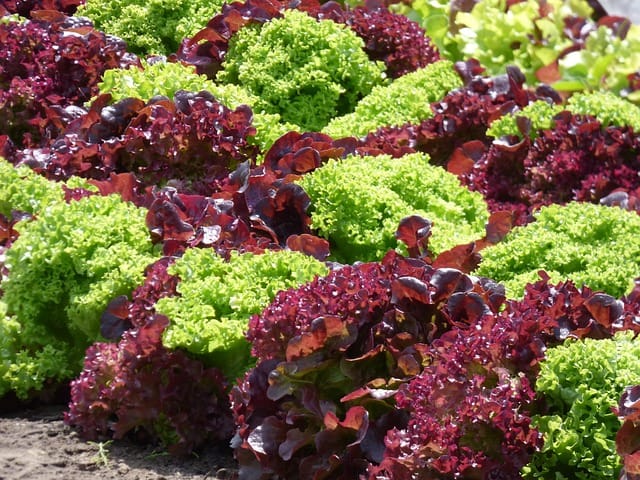Lettuce, with its crisp leaves and refreshing flavor, is a true garden classic. From the delicate butterhead to the crunchy romaine to the frilly looseleaf varieties, there’s a lettuce out there for everyone.
Imagine strolling through your garden, the sun on your face, and harvesting a head of lettuce so fresh it practically snaps in your hand. That crisp texture, the slightly sweet, earthy flavor – it’s a taste of homegrown goodness you won’t soon forget. Whether you’re a seasoned gardener or just starting out, lettuce is easy to grow and a great addition to your garden. It is one of the 13 best easy-to-grow garden vegetables.

Why Grow Lettuce?
- Super Simple: Lettuce is incredibly easy to grow, making it a perfect choice for those new to gardening.
- Fast Growers: You won’t have to wait long to enjoy the fruits (or should I say, leaves?) of your labor.
- Salad Stars: Lettuce is the essential ingredient in countless delicious salads.
- Versatile Veggies: From wraps to sandwiches to soups, lettuce can be used in a wide variety of culinary creations.
- Continuous Harvest: You can harvest lettuce leaves continuously throughout the growing season, ensuring a steady supply of fresh greens.
- Garden Beauties: The various colors and textures of lettuce add a touch of beauty to your garden.
How to Eat Lettuce:
- Salad Sensations: Lettuce is the star of any great salad.
- Wrap Stars: Use large lettuce leaves as wraps for your favorite fillings.
- Sandwich Staples: Lettuce adds a refreshing crunch to sandwiches and burgers.
- Soup Garnishes: A few fresh lettuce leaves can add a pop of color and freshness to soups.
- Lettuce Cups: Use lettuce leaves as cups for appetizers or light meals.
- Smoothie Boosters: Add lettuce to your favorite smoothie for a boost of nutrients.
Growing Lettuce:
Lettuce is a cool-season annual, meaning it completes its life cycle in one year. It prefers cooler temperatures and can be planted in early spring or late summer.
- Planting Power: You can start lettuce seeds indoors a few weeks before the last frost or sow them directly into the ground once the soil has warmed up.
- Watering Wisdom: Lettuce needs consistent moisture, especially during germination and growth.
- Fertilizing Fundamentals: Lettuce benefits from regular feeding with a balanced fertilizer.
- Sunshine State of Mind: Lettuce prefers full sun to partial shade.
- Soil Savvy: It grows best in well-drained soil that is rich in organic matter.
- Harvesting Happiness: Lettuce can be harvested when the leaves are large enough to use. Cut the outer leaves, allowing the inner leaves to continue growing.
Tips and Tricks:
- Pest Patrol: Keep an eye out for common lettuce pests like slugs and aphids.
- Succession Planting: Plant a new batch of seeds every few weeks for a continuous harvest throughout the season.
- Mulching Magic: Mulching around lettuce plants helps retain moisture and suppress weeds.
- Don’t Overwater: Overwatering can lead to root rot.
- Bolting Prevention: Lettuce can bolt (go to seed) in hot weather, so provide some shade during the hottest part of the day.
Lettuce Cuisine:
Lettuce is incredibly versatile in the kitchen. Let’s try a recipe that’s a little more creative than just tossing it in a salad:

Grilled Romaine Salad with Caesar Dressing:
This is a delicious and unexpected way to enjoy romaine lettuce.
- 2 heads romaine lettuce, halved lengthwise
- 2 tablespoons olive oil
- Salt and pepper to taste
- For the Caesar Dressing:
- ½ cup mayonnaise
- ¼ cup grated Parmesan cheese
- 2 tablespoons lemon juice
- 1 tablespoon Worcestershire sauce
- 1 clove garlic, minced
- Salt and pepper to taste
- Brush the romaine lettuce halves with olive oil and season with salt and pepper.
- Grill the lettuce halves over medium heat for 2-3 minutes per side, or until slightly charred.
- For the dressing, whisk together mayonnaise, Parmesan cheese, lemon juice, Worcestershire sauce, garlic, salt, and pepper in a bowl.
- Drizzle the Caesar dressing over the grilled romaine lettuce.
- Serve and enjoy!
Nutritional Value:
According to the USDA FoodData Central, lettuce is a good source of vitamin A, vitamin K, and folate. It is also low in calories and fat. Nutritional values vary depending on the type of lettuce.
| Nutrient | Amount per 100g (Romaine, raw) |
|---|---|
| Calories | 16 kcal |
| Vitamin K | 127 mcg |
| Vitamin A | 5267 IU |
| Folate, total | 38 mcg |
| Vitamin C | 8.1 mg |
| Fiber | 1.7 g |
Summary and Conclusion:
Lettuce is a fantastic addition to any garden, especially for beginner gardeners. It’s easy to grow, versatile, and oh-so-delicious. So grab some seeds or seedlings, get your hands a little dirty, and experience the joy of growing your own lettuce!
Disclaimer: This post is for informational purposes only and should not be construed as health, wellness or nutrition advice. Please see our full disclaimers here.
« Back to Glossary Index
